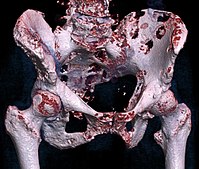
Photo from wikipedia
Abstract There are no criteria for patient selection for ovarian-preserving surgery for endometrial cancer (EC). In this study, intraoperative findings of ovarian swelling (OvS) and the clinicopathological features of patients… Click to show full abstract
Abstract There are no criteria for patient selection for ovarian-preserving surgery for endometrial cancer (EC). In this study, intraoperative findings of ovarian swelling (OvS) and the clinicopathological features of patients with EC with or without ovarian metastasis were analysed to identify risk factors for ovarian metastasis. Patients who underwent surgery for EC between 2012 and 2019 at our hospital were enrolled. In univariate analysis, all features were significantly higher in metastasis(+) cases. In multivariate analysis, lymphatic space invasion (LSI), cervical stromal involvement (CSI), peritoneal dissemination, and OvS were significant risk factors. In univariate analysis in stage I and II cases classified without adnexal pathological factors, type 2 histologic type, LSI, CSI, and OvS were significantly higher in metastasis(+) cases. LSI, CSI, and OvS were significant risk factors in multivariate analysis. Patients with type 1 histologic type EC without myometrial invasion ≥1/2, CSI and extrauterine lesions are appropriate for ovarian preservation. IMPACT STATEMENT What is already known on this subject? The number of premenopausal patients with endometrial cancer (EC) is increasing. Bilateral oophorectomy for EC results in surgical primary ovarian insufficiency, and thus, surgery with ovarian preservation has been examined. However, there are few reports on risk factors for ovarian metastasis of EC and no established criteria for patient background or pathological factors to determine suitability for ovarian preservation surgery. What do the results of this study add? In univariate analysis, all pathological findings suggestive of disease progression were more frequent in cases with ovarian metastases. In multivariate analysis, lymphatic space invasion (LSI), cervical stromal involvement (CSI), peritoneal dissemination, and ovarian swelling (OvS) were identified as significant risk factors for ovarian metastasis. In an analysis of stage I and II cases classified without adnexal pathological factors, type 2 histologic type, LSI, CSI, and OvS were significantly more common in cases with ovarian metastasis, and LSI, CSI, and OvS emerged as significant risk factors for ovarian metastasis in multivariate analysis. What are the implications of these findings for clinical practice and/or further research? Patients with type 1 histologic type EC without depth of myometrial invasion ≥1/2, CSI, or extrauterine lesions may be appropriate cases for ovarian preservation.
Journal Title: Journal of Obstetrics and Gynaecology
Year Published: 2022
Link to full text (if available)
Share on Social Media: Sign Up to like & get
recommendations!